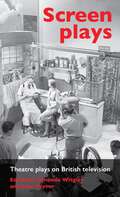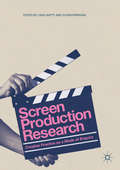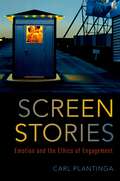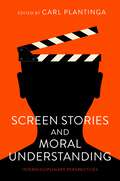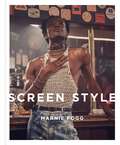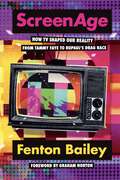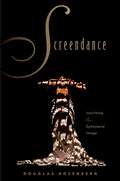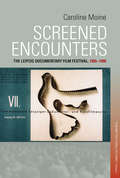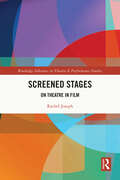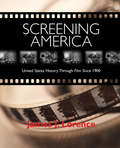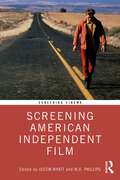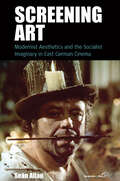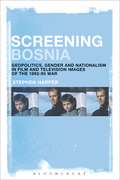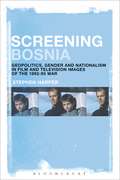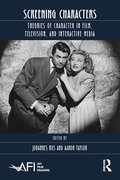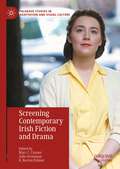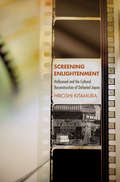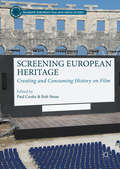- Table View
- List View
Screen plays: Theatre plays on British television
by Amanda Wrigley John WyverScreen plays is a ground-breaking collection that chronicles the rich and surprising history of stage plays produced for the small screen between 1930 and the present. The volume opens with a substantial historical outline of how plays originally written for the theatre have been presented by the BBC and ITV, as well as independent producers and cultural organisations. Subsequent chapters utilise a variety of critical methodologies to analyse a wide range of outside broadcasts from theatres, screen adaptations of existing stage productions, along with original television productions of classic and contemporary drama. Making a compelling case for the centrality of the theatre to British television’s past and present, Screen plays opens up new areas of research for all those engaged in theatre, media and adaptation studies.
Screen Production Research: Creative Practice as a Mode of Enquiry
by Craig Batty Susan KerriganAimed at students and educators across all levels of Higher Education, this agenda-setting book defines what screen production research is and looks like—and by doing so celebrates creative practice as an important pursuit in the contemporary academic landscape. Drawing on the work of international experts as well as case studies from a range of forms and genres—including screenwriting, fiction filmmaking, documentary production and mobile media practice—the book is an essential guide for those interested in the rich relationship between theory and practice. It provides theories, models, tools and best practice examples that students and researchers can follow and expand upon in their own screen production projects.
Screen Production Research: Creative Practice as a Mode of Enquiry
by Craig Batty Susan KerriganAimed at students and educators across all levels of Higher Education, this agenda-setting book defines what screen production research is and looks like—and by doing so celebrates creative practice as an important pursuit in the contemporary academic landscape. Drawing on the work of international experts as well as case studies from a range of forms and genres—including screenwriting, fiction filmmaking, documentary production and mobile media practice—the book is an essential guide for those interested in the rich relationship between theory and practice. It provides theories, models, tools and best practice examples that students and researchers can follow and expand upon in their own screen production projects.
Screen Stories: Emotion and the Ethics of Engagement
by Carl PlantingaThe way we communicate with each other is vital to preserving the cultural ecology, or wellbeing, of a place and time. Do we listen to each other? Do we ask the right questions? Do we speak about each other with respect or disdain? The stories that we convey on screens, or what author Carl Plantinga calls 'screen stories,' are one powerful and pervasive means by which we communicate with each other. Screen Stories: Emotion and the Ethics of Engagement argues that film and media studies needs to move toward an an approach to ethics that is more appropriate for mass consumer culture and the lives of its citizens. Primarily concerned with the relationship between media and viewers, this book considers ethical criticism and the emotional power of screen stories that makes such criticism necessary. The content we consume--from television shows and movies to advertisements--can significantly affect our welfare on a personal and societal level, and thus, this content is subject to praise and celebration, or questioning and even condemnation. The types of screen stories that circulate contribute to the cultural ecology of a time and place; through shared attention they influence what individuals think and feel. Plantinga develops a theory of the power of screen stories to affect both individuals and cultures, asserting that we can better respond ethically to such media if we understand the sources of its influence on us.
Screen Stories and Moral Understanding: Interdisciplinary Perspectives
by Carl PlantingaThe stories we tell and show, in whatever medium, play varied roles in human cultures. One such role is to contribute to moral understanding. Moral understanding goes beyond moral knowledge; it is a complex cognitive achievement that may consist of one or more of the following: the ability to understand why, to ask the right questions, categorization, the application of models to specific incidents, or the capacity to make connections between morally charged situations that have a common underlying meaning. While the disciplines of communication, psychology, philosophy, and film and media studies have all made significant scholarly progress on this issue, they make different grounding assumptions and use different terminologies. Screen Stories and Moral Understanding approaches the topic from an interdisciplinary perspective and explores the conditions under which stories we view on screens-movies, streamed series, and television-can lead to moral understanding in viewers. In five sections, this book explores the nature of moral understanding in relation to screen stories, the means by which moving image fictions can transfer knowledge to and cultivate perspectives in viewers, the role of affect in generating moral understanding, the viewer's engagement with characters, and what we do with screen stories after viewing them.
Screen Stories and Moral Understanding: Interdisciplinary Perspectives
The stories we tell and show, in whatever medium, play varied roles in human cultures. One such role is to contribute to moral understanding. Moral understanding goes beyond moral knowledge; it is a complex cognitive achievement that may consist of one or more of the following: the ability to understand why, to ask the right questions, categorization, the application of models to specific incidents, or the capacity to make connections between morally charged situations that have a common underlying meaning. While the disciplines of communication, psychology, philosophy, and film and media studies have all made significant scholarly progress on this issue, they make different grounding assumptions and use different terminologies. Screen Stories and Moral Understanding approaches the topic from an interdisciplinary perspective and explores the conditions under which stories we view on screens-movies, streamed series, and television-can lead to moral understanding in viewers. In five sections, this book explores the nature of moral understanding in relation to screen stories, the means by which moving image fictions can transfer knowledge to and cultivate perspectives in viewers, the role of affect in generating moral understanding, the viewer's engagement with characters, and what we do with screen stories after viewing them.
SCREEN STORIES C: Emotion and the Ethics of Engagement
by Carl PlantingaThe way we communicate with each other is vital to preserving the cultural ecology, or wellbeing, of a place and time. Do we listen to each other? Do we ask the right questions? Do we speak about each other with respect or disdain? The stories that we convey on screens, or what author Carl Plantinga calls 'screen stories,' are one powerful and pervasive means by which we communicate with each other. Screen Stories: Emotion and the Ethics of Engagement argues that film and media studies needs to move toward an an approach to ethics that is more appropriate for mass consumer culture and the lives of its citizens. Primarily concerned with the relationship between media and viewers, this book considers ethical criticism and the emotional power of screen stories that makes such criticism necessary. The content we consume--from television shows and movies to advertisements--can significantly affect our welfare on a personal and societal level, and thus, this content is subject to praise and celebration, or questioning and even condemnation. The types of screen stories that circulate contribute to the cultural ecology of a time and place; through shared attention they influence what individuals think and feel. Plantinga develops a theory of the power of screen stories to affect both individuals and cultures, asserting that we can better respond ethically to such media if we understand the sources of its influence on us.
Screen Style
by Marnie FoggScreen Style celebrates the beautiful, stylish and often covetable outfits and costumes featured in 50 iconic and diverse series of the small screen: from Mad Men to Call My Agent, Bridgerton to Empire.By organising the series into genres - Comedy, Coming of Age, Crime, Historical, Retro, Contemporary - the author shows how designers take different approaches when manipulating the latent power of dress to create convincing characters and enhance the experience of the viewer. She reveals how the characters themselves can become role models for what to wear, transforming actors into fashion influencers.The book is beautifully illustrated with over 250 screen stills, each accompanied by an extended caption, further demonstrating how TV series have helped to set the standard for fashion on and off screen.
ScreenAge: How TV shaped our reality, from Tammy Faye to RuPaul’s Drag Race
by Fenton Bailey'Like a superheated kernel of corn, the world has gone Pop... Drag has become mainstream. Being gay became cool. From being the criminal outsider, being queer has even become representative of the way the outsider voice is common to us all.'When he moved to New York in 1982, Fenton Bailey saw the world go Pop. Together with filmmaking partner Randy Barbato, their production company World of Wonder would pioneer the genre of Reality TV and chronicle the emerging Screen Age through their extraordinary programs and outrageous subjects - from Bible Belt televangelists and conspiracy theories to pioneering drag queens.Working with icons such as Britney Spears, Tammy Faye Bakker and RuPaul, the production company's shows tell a wider story of how television has fundamentally shifted our reality.Packed with glorious insider gossip and amazing celebrity stories, these are the riotous tales behind the shows that would make ScreenAgers of us all.
Screendance: Inscribing the Ephemeral Image
by Douglas RosenbergThe relationship between the practice of dance and the technologies of representation has excited artists since the advent of film. Dancers, choreographers, and directors are increasingly drawn to screendance, the practice of capturing dance as a moving image mediated by a camera. While the interest in screendance has grown in importance and influence amongst artists, it has until now flown under the academic radar. Emmy-nominated director and auteur Douglas Rosenberg's groundbreaking book considers screendance as both a visual art form as well as an extension of modern and post-modern dance without drawing artificial boundaries between the two. Both a history and a critical framework, Screendance: Inscribing the Ephemeral Image is a new and important look at the subject. As he reconstructs the history and influences of screendance, Rosenberg presents a theoretical guide to navigating the boundaries of an inherently collaborative art form. Drawing on psycho-analytic, literary, materialist, queer, and feminist modes of analysis, Rosenberg explores the relationships between camera and subject, director and dancer, and the ephemeral nature of dance and the fixed nature of film. This interdisciplinary approach allows for a broader discussion of issues of hybridity and mediatized representation as they apply to dance on film. Rosenberg also discusses the audiences and venues of screendance and the tensions between commercial and fine-art cultures that the form has confronted in recent years. The surge of screendance festivals and courses at universities around the world has exposed the friction that exists between art, which is generally curated, and dance, which is generally programmed. Rosenberg explores the cultural implications of both methods of reaching audiences, and ultimately calls for a radical new way of thinking of both dance and film that engages with critical issues rather than simple advocacy.
Screened Encounters: The Leipzig Documentary Film Festival, 1955-1990 (Film and the Global Cold War #1)
by Caroline MoineEstablished in 1955, the Leipzig International Documentary Film Festival became a central arena for staging the cultural politics of the German Democratic Republic, both domestically and in relation to West Germany and the rest of the world. Screened Encounters represents the definitive history of this key event, recounting the political and artistic exchanges it enabled from its founding until German unification, and tracing the outsize influence it exerted on international cultural relations during the Cold War.
Screened Stages: On Theatre in Film (ISSN)
by Rachel JosephThis book is devoted to tracing the variety of ways that theatre, theatricality, and performance are embedded in Hollywood cinema as screened stages.A screened stage is the literal or metaphorical appearance of a stage on screen. When the Hollywood style emerged in cinema history it traumatically severed the entwined relationship between film and theatre. The book makes the argument that cinema longs for theatre after that separation. The histories of stage and screen persistently crisscross one another making their separation problematic. The screened stage from the end of the nineteenth century until now offers a miniaturized version of cinema and theatre history. Moments of the stage within the screen compress historical styles and movements into saturated representations on film. Such examples overflow the cinematic screen into singular manifestations of presentness. Screened stages uncover what it means to be simultaneously present and absent.This book would be of great interest to students and scholars of theatre, film, dance, and performance.
Screened Stages: On Theatre in Film (ISSN)
by Rachel JosephThis book is devoted to tracing the variety of ways that theatre, theatricality, and performance are embedded in Hollywood cinema as screened stages.A screened stage is the literal or metaphorical appearance of a stage on screen. When the Hollywood style emerged in cinema history it traumatically severed the entwined relationship between film and theatre. The book makes the argument that cinema longs for theatre after that separation. The histories of stage and screen persistently crisscross one another making their separation problematic. The screened stage from the end of the nineteenth century until now offers a miniaturized version of cinema and theatre history. Moments of the stage within the screen compress historical styles and movements into saturated representations on film. Such examples overflow the cinematic screen into singular manifestations of presentness. Screened stages uncover what it means to be simultaneously present and absent.This book would be of great interest to students and scholars of theatre, film, dance, and performance.
Screening America: United States History through Film since 1900
by James J LorenceBy combining the study of films with the text-based primary sources, Screening America gives students clear guidance in studying, interpreting, and understanding the motion picture's significance as a primary source in investigating U.S. History.Students will come to understand history as not only the record of what governments did, but also the way in which people lived their lives, experienced the wider world, and engaged in leisure pursuits, from which we can learn much about the society in which they lived.
Screening America: United States History through Film since 1900
by James J LorenceBy combining the study of films with the text-based primary sources, Screening America gives students clear guidance in studying, interpreting, and understanding the motion picture's significance as a primary source in investigating U.S. History.Students will come to understand history as not only the record of what governments did, but also the way in which people lived their lives, experienced the wider world, and engaged in leisure pursuits, from which we can learn much about the society in which they lived.
Screening American Independent Film (Screening Cinema)
by Justin Wyatt W. D. PhillipsThis indispensable collection offers 51 chapters, each focused on a distinct American independent film. Screening American Independent Film presents these films chronologically, addressing works from across more than a century (1915−2020), emphasizing the breadth and long duration of American independent cinema. The collection includes canonical examples as well as films that push against and expand the definitions of "independence." The titles run from micro-budget films through marketing-friendly Indiewood projects, from auteur-driven films and festival darlings to B-movies, genre pics, and exploitation films. The chapters also introduce students to different approaches within film studies including historical and contextual framing, industrial and institutional analysis, politics and ideology, genre and authorship, representation, film analysis, exhibition and reception, and technology. Written by leading international scholars and emerging talents in film studies, this volume is the first of its kind. Paying particular attention to issues of diversity and inclusion for both the participating scholars and the content and themes within the selected films, Screening American Independent Film is an essential resource for anyone teaching or studying American cinema.
Screening American Independent Film (Screening Cinema)
This indispensable collection offers 51 chapters, each focused on a distinct American independent film. Screening American Independent Film presents these films chronologically, addressing works from across more than a century (1915−2020), emphasizing the breadth and long duration of American independent cinema. The collection includes canonical examples as well as films that push against and expand the definitions of "independence." The titles run from micro-budget films through marketing-friendly Indiewood projects, from auteur-driven films and festival darlings to B-movies, genre pics, and exploitation films. The chapters also introduce students to different approaches within film studies including historical and contextual framing, industrial and institutional analysis, politics and ideology, genre and authorship, representation, film analysis, exhibition and reception, and technology. Written by leading international scholars and emerging talents in film studies, this volume is the first of its kind. Paying particular attention to issues of diversity and inclusion for both the participating scholars and the content and themes within the selected films, Screening American Independent Film is an essential resource for anyone teaching or studying American cinema.
Screening Art: Modernist Aesthetics and the Socialist Imaginary in East German Cinema (Film Europa #20)
by Seán AllanWith internationalist aspirations and wide-ranging historical perspectives, East German films about artists and their work became hotly contested spaces in which filmmakers could look beyond the GDR and debate the impact of contemporary cultural policy on the reception of their pre-war cultural heritage. Spanning newsreels, documentaries, and feature films, Screening Art is the first full-length investigation into a genre that has been largely overlooked in studies of DEFA, the state-owned Eastern German film studio. As it shows, “artist-films” played an essential role in the development of new paradigms of socialist art in postwar Europe.
Screening Bosnia: Geopolitics, Gender and Nationalism in Film and Television Images of the 1992-95 War
by Stephen HarperThe Bosnian war of 1992-1995 was one of the most brutal conflicts to have erupted since the end of the Second World War. But although the war occurred in 'Europe's backyard' and received significant media coverage in the West, relatively little scholarly attention has been devoted to cultural representations of the conflict. Stephen Harper analyses how the war has been depicted in global cinema and television over the past quarter of a century. Focusing on the representation of some of the war's major themes, including humanitarian intervention, the roles of NATO and the UN, genocide, rape and ethnic cleansing, Harper explores the role of popular media culture in reflecting, reinforcing -- and sometimes contesting -- nationalist ideologies.
Screening Bosnia: Geopolitics, Gender and Nationalism in Film and Television Images of the 1992-95 War
by Stephen HarperThe Bosnian war of 1992-1995 was one of the most brutal conflicts to have erupted since the end of the Second World War. But although the war occurred in 'Europe's backyard' and received significant media coverage in the West, relatively little scholarly attention has been devoted to cultural representations of the conflict. Stephen Harper analyses how the war has been depicted in global cinema and television over the past quarter of a century. Focusing on the representation of some of the war's major themes, including humanitarian intervention, the roles of NATO and the UN, genocide, rape and ethnic cleansing, Harper explores the role of popular media culture in reflecting, reinforcing -- and sometimes contesting -- nationalist ideologies.
Screening Characters: Theories of Character in Film, Television, and Interactive Media (AFI Film Readers)
by Johannes Riis Aaron TaylorCharacters are central to our experiences of screened fictions and invite a host of questions. The contributors to Screening Characters draw on archival material, interviews, philosophical inquiry, and conceptual analysis in order to give new, thought-provoking answers to these queries. Providing multifaceted accounts of the nature of screen characters, contributions are organized around a series of important subjects, including issues of class, race, ethics, and generic types as they are encountered in moving image media. These topics, in turn, are personified by such memorable figures as Cary Grant, Jon Hamm, Audrey Hepburn, and Seul-gi Kim, in addition to avatars, online personalities, animated characters, and the ensembles of shows such as The Sopranos, Mad Men, and Breaking Bad.
Screening Characters: Theories of Character in Film, Television, and Interactive Media (AFI Film Readers)
by Johannes Riis Aaron TaylorCharacters are central to our experiences of screened fictions and invite a host of questions. The contributors to Screening Characters draw on archival material, interviews, philosophical inquiry, and conceptual analysis in order to give new, thought-provoking answers to these queries. Providing multifaceted accounts of the nature of screen characters, contributions are organized around a series of important subjects, including issues of class, race, ethics, and generic types as they are encountered in moving image media. These topics, in turn, are personified by such memorable figures as Cary Grant, Jon Hamm, Audrey Hepburn, and Seul-gi Kim, in addition to avatars, online personalities, animated characters, and the ensembles of shows such as The Sopranos, Mad Men, and Breaking Bad.
Screening Contemporary Irish Fiction and Drama (Palgrave Studies in Adaptation and Visual Culture)
by Marc C. Conner Julie Grossman R. Barton PalmerIn this book, each chapter explores significant Irish texts in their literary, cultural, and historical contexts. With an introduction that establishes the multiple critical contexts for Irish cinema, literature, and their adaptive textual worlds, the volume addresses some of the most popular and important late 20th-Century and 21st Century works that have had an impact on the Irish and global cinema and literary landscape. A remarkable series of acclaimed and profitable domestic productions during the past three decades has accompanied, while chronicling, Ireland’s struggle with self-identity, national consciousness, and cultural expression, such that the story of contemporary Irish cinema is in many ways the story of the young nation’s growth pains and travails. Whereas Irish literature had long stood as the nation’s foremost artistic achievement, it is not too much to say that film now rivals literature as Ireland’s key form of cultural expression. The proliferation of successful screen versionings of Irish fiction and drama shows how intimately the contemporary Irish cinema is tied to the project of both understanding and complicating (even denying) a national identity that has undergone radical change during the past three decades. This present volume is the first to present a collective accounting of that productive synergy, which has seen so much of contemporary Irish literature transferred to the screen.
Screening Enlightenment: Hollywood and the Cultural Reconstruction of Defeated Japan (The United States in the World)
by Hiroshi KitamuraDuring the six-and-a-half-year occupation of Japan (1945–1952), U.S. film studios—in close coordination with Douglas MacArthur's Supreme Command for the Allied Powers—launched an ambitious campaign to extend their power and influence in a historically rich but challenging film market. In this far-reaching "enlightenment campaign," Hollywood studios disseminated more than six hundred films to theaters, earned significant profits, and showcased the American way of life as a political, social, and cultural model for the war-shattered Japanese population. In Screening Enlightenment, Hiroshi Kitamura shows how this expansive attempt at cultural globalization helped transform Japan into one of Hollywood's key markets. He also demonstrates the prominent role American cinema played in the "reeducation" and "reorientation" of the Japanese on behalf of the U.S. government.According to Kitamura, Hollywood achieved widespread results by turning to the support of U.S. government and military authorities, which offered privileged deals to American movies while rigorously controlling Japanese and other cinematic products. The presentation of American ideas and values as an emblem of culture, democracy, and sophistication also allowed the U.S. film industry to expand. However, the studios' efforts would not have been nearly as extensive without the Japanese intermediaries and consumers who interestingly served as the program's best publicists. Drawing on a wide range of sources, from studio memos and official documents of the occupation to publicity materials and Japanese fan magazines, Kitamura shows how many Japanese supported Hollywood and became active agents of Americanization. A truly interdisciplinary book that combines U.S. diplomatic and cultural history, film and media studies, and modern Japanese history, Screening Enlightenment offers new insights into the origins of this unique political and cultural transpacific relationship.
Screening European Heritage: Creating and Consuming History on Film (Palgrave European Film and Media Studies)
by Rob Stone Paul CookeThis book provides a unique examination of the way Europe’s past is represented on contemporary screens and what this says about contemporary cultural attitudes to history. How do historical dramas come to TV and cinema screens across Europe? How is this shaped by the policies and practices of cultural institutions, from media funding boards to tourist agencies and heritage sites? Who watches these productions and how are they consumed in cinemas, on TV and online?, are just some of the questions this volume seeks to answer. From The Lives of Others to Game of Thrones, historical dramas are a particularly visible part of mainstream European film production, often generating major national debates on the role of the past in contemporary national identity construction.
